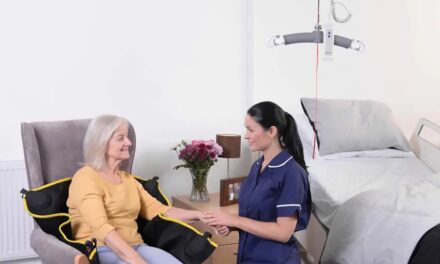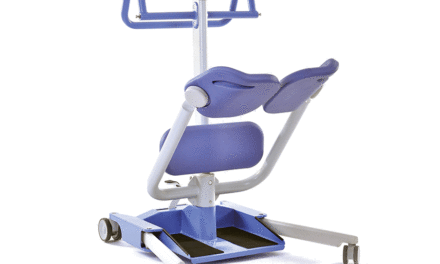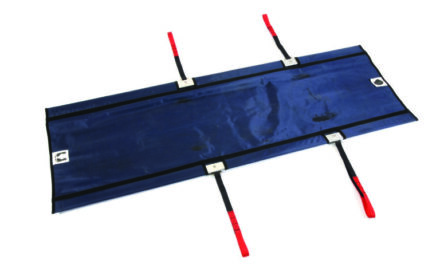In any moving and handling situation, it is imperative to assess and mitigate any risks to both patient and carer provider. This is especially important when using lift and sling combinations. And even more so when electing to use a toileting or hygiene sling. As the associated risks are often much higher. As an Oxford toileting sling supplier, we wanted to share how to minimise the risks.
Related: Portable Hoists: Travelling Outside the Confines of the Home
What Is A Toileting Sling?
A toileting sling is one of the more common sling shapes and is specifically designed to facilitate the toileting process. With that in mind, a true toileting sling generally has a minimalist and open design that ensures excellent access to clothing. A toileting sling is very easy to fit and can also assist with dressing and other personal care tasks.
Due to the inherent design, there are safety concerns that need to be addressed as part of a face-to-face risk assessment with the patient prior to use. These include sizing, fitting, support levels, padding, and of course patient conditions and abilities. Therefore, it is critical that a comprehensive assessment is carried out in each individual case. Despite being very easy to fit, toileting slings should never be considered general-purpose slings and they will not be suitable and/or safe for many patients.

Minimising The Risks
The completion of a risk assessment before use and care plan documentation should be carried out by someone with the appropriate competence (training and skills). This is to ensure a validated decision as to the equipment and techniques required for each individual. It is equally essential that the carer is familiar with the manufacturer’s instructions, application and associated limitations of the equipment. Additionally, LOLER checks, care plans and risk assessments must be continually conducted and reviewed with any changes in the person’s condition or abilities being made known.
The person conducting the risk management plan must ensure all information is documented accurately. Especially in sufficient detail so that handlers can use patient handling equipment safely and effectively. This includes but is not limited to, specifying the appropriate hoist, selecting the type, and size of the sling, configurations of loops, use of supportive accessories and the number of handlers needed to carry out the task safely.
It is sometimes helpful to include a photograph as part of the risk assessment documentation for additional context. Furthermore, the risk management plan must be clearly communicated to all handlers and made readily accessible for reference.
Individual Patient Assessment And Correct Sizing Is Essential
A very careful individual patient assessment must be made before using toileting slings and correct sizing is essential. The person that is lifted must have a good tone and sitting balance with an FIM score of 2 or 3. Also, the individual should be able to cooperate and understand instructions. Such as keeping arms on the outside of the sling. If the patient does not meet the above criteria, then they are likely to be unsuitable for this type of sling and you should consider alternative options.
It is important to note that a patient’s physical and cognitive abilities may change throughout the course of a day. For example, he/she may have good strength on a morning (sling may be deemed suitable) but this declines later in the day, due to fatigue and the sling may become unsuitable. This is why it is important that a dynamic risk assessment is carried out each and every time, prior to lifting.
Fitting And Positioning
It is important that you position the sling with the lower edge of the back panel sat just below waist level. This ensures that when the waist strap is brought round and fastened, it will be on the waist. If the sling is not positioned low enough, it could slip up slightly, causing discomfort under the axilla. Additionally, if the sling is even slightly too big, this could also cause discomfort in the person’s axilla. It is recommended to follow the sling manufacturer’s user instructions prior to use.
The Oxford Range And Benefits:
The Oxford range of toileting slings (Access Padded, Toileting Plus and Toileting Low) has features addressing multiple lifting requirements and applications. In particular, the slings are easy to fit, provide excellent access and offer excellent support and durability. Here are a few benefits:
- Non-slip back section to help ensure the sling does not ‘ride up’
- Adjustable, elasticated body belt for added support and security
- Padded under-arm and leg sections for comfort
- Coloured attachment loops promote correct/safe positioning
- Customisable to fulfil patient-specific needs
Additionally, Joerns supply toileting slings with loop and clip variants for both spreader bar and cradle compatibility. As well as head support options and a range of sizes. As a result, Oxford slings are suitable for a wider range of clients, including those with reduced head control.
Summary
It is essential that you carry out a full risk assessment before using a toileting sling. This ensures the ongoing safety and welfare of patients and carers. With that in mind here is a recap of some of the things you need to consider as part of the process to mitigate risk and ensure patient safety.
- Physiological condition – medical conditions and skin integrity
- Physical abilities – ability to assist, motor function and upper body control.
- Weight and size of user – load-bearing capacity and safe to lift (consider hoist too).
- Function – this should be specific to each individual as this is not a multi-purpose transfer sling. It is a specific function sling.
- Laundering – cross-contamination can have serious health implications which means laundering at a bacterial killing temperature is essential.
- Attachment type – Clip or loop? Spreader bar or cradle compatibility.
We’re A Leading Toileting Sling Supplier, Contact Us For More Information
Joerns Healthcare supply a wide range of patient slings for a variety of applications, including toileting slings. We have over 65 years of experience and expertise, so if you need help making the right decision then call us today on +44 (0)344 811 1158 to discuss your requirements.
If you have found this blog helpful, then you may wish to read our previous blog on LOLER: A Guide to Hoist Servicing & Maintenance or Active Stand Aids: A Patient Journey
To read the original article please see here



